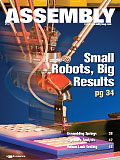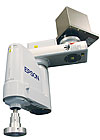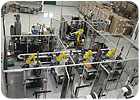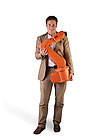
Traditionally, robots have required a large footprint and a big pocketbook. However, a new breed of lightweight, benchtop machines provide big performance in a small package. Mini robots offer a cost-effective way to handle and assemble small parts, especially when space is scarce.
Compact robots are used for numerous assembly applications, such as dispensing, screwdriving and soldering, in addition to clean room environments. Manufacturers rely on small robots to mass-produce cell phones, iPods, and plasma TVs, in addition to solar panels, syringes and automotive electronic control units. They’re also used for polishing and machine tending applications.
But, defining what “small” means is open to interpretation. What one manufacturing engineer thinks is small might be considered large by someone in a different industry.
“Small is relative, especially in the auto industry,” explains Tony Marchelletta, business development manager at QSI Automation Inc., a systems integrator that specializes in plastic injection-molding applications. “Someone in the medical device industry would probably see things much differently.”
Typically, small robots are classified based on their reach and payload, such as a reach of 1,000 millimeters or less and a payload capacity of less than 5 kilograms. “There have been some discussions recently of motor wattages defining robot size, but this is more akin to electricity consumption of the arm, not stature,” says Phil Baratti, applications engineering manager at EPSON Robots.
Small robots are ideal for applications that require high precision. “In particular to four-axis SCARA robots, the ability to calculate an X-Y distance from a rotary device is heavily dependent on arm length,” Baratti points out.
“Some small robots have a very small footprint with a large working envelope, while others have a small footprint with a limited working environment,” adds David Arceneaux, operations manager at Stäubli Corp. “For example, some robots have a true spherical envelope, while others only have a tear-drop work envelope. Robots with the spherical envelope will be able to work much more efficiently within the same footprint with minimum dead space around the robot arm.”

This SCARA robot features a zero footprint arm that saves valuable floor space.
Diverse Market
EPSON recently unveiled the G1 Mini SCARA, which Baratti claims “leads the industry in footprint-to-workspace ratio. The 225-millimeter robot arms can handle many applications with large working range requirements that other robots need 250 millimeters of reach to handle, thus saving our customers valuable floor space.”According to Baratti, there has been considerable improvement in robot design when it comes to working area vs. footprint. For instance, EPSON engineers recently developed a new type of SCARA robot that allows the second arm to bend into the first by way of curving the first arm.
“This has considerably improved our inside dead space radius,” says Baratti. “An even better design for reducing footprint to workspace is the RS robot, which is literally a zero footprint arm.”
Robot vendors have also been busy developing small versions of other popular configurations, such as delta robots, six-axis robots and Cartesian robots. For instance, FANUC Robotics America Inc. recently introduced the M-1iA, a delta robot that weighs less than 20 kilograms. The compact machine can be mounted on a desktop, floor, wall or ceiling to tackle a wide variety of small part handling and assembly tasks.
“It is [our] first small robot to have a parallel link mechanism, which is ideal for high-speed applications,” says Chris Blanchette, manager of national distribution sales at FANUC Robotics. “In addition, it is available in a four- or six-axis configuration. This level of flexibility far exceeds the capabilities of other vertically-articulated or SCARA-type robots that only offer three- or four-axis configurations.” The six-axis model provides a flexible wrist articulation for assembly applications.
Jim Kosmala, channel partner manager at ABB Robotics, defines a “small robot” as a tabletop machine that one person can pick up and move around. The new ABB IRB 120 robot fits that description. It weighs only 55 pounds.
“The six-axis robot has all the functionality and advanced design features of ABB’s larger robots in an economical, lightweight model,” says Kosmala. “The IRB 120 features a standard payload of 3 kilograms and a reach of 580 millimeters. By comparison, the IRB 7600 has a 500-kilogram payload and a reach of 3.5 meters.”
Janome Industrial Equipment USA Inc. has been manufacturing desktop robots for more than 20 years. Its smallest Cartesian robot is the JR2203NE, which boasts a minimal footprint of 15.25 inches by 12.6 inches, making it ideal for use where space is at a premium.
According to Phil Cohen, national sales manager, the machine is designed to “minimize footprint and maximize the efficiency of assembly line operations. Many manufacturing plants are being asked to do more with the space they have. Small robots support both the efficiencies of the tasks and physical floor real estate.” To meet that need, Janome has developed software for various screwdriving, soldering, dispensing and PCB depaneling applications.
Traditionally, tabletop Cartesian robots have been extremely popular for adhesive dispensing applications. That’s why companies such as EFD Inc., Fisnar Inc., Henkel Corp., Liquid Control Corp., and Sealant Equipment & Engineering Inc. market a wide variety of benchtop systems.

Mini robots offer a cost-effective way to assemble small parts, especially when space is scarce.
Smaller and More Powerful
The size, weight, performance and cost of today’s compact robots were unthinkable just a few years ago. In addition, current business conditions have made some engineers realize that bigger isn’t necessarily better when it comes to robotics.“Large capital equipment budgets have been drastically reduced, if not eliminated,” Cohen points out. “Small robots offer a way to phase-in automation over time, where a positive return on investment can be shown quickly. From that point, additional units can be purchased to collectively build upon the level of automation throughout the assembly line or manufacturing cell.”
“Small robots cost much less than [larger] robots and require less programming or third-party support,” adds Cohen. “This makes the overall small robot solution less expensive.”
Moore’s Law applies to robots, in addition to computers, cell phones and other devices. “They keep getting smaller and less expensive, while functionality increases,” notes Kosmala. “We’ve seen increasing demand in recent years. It can be an affordable and flexible entryway for manufacturers that are not currently using robots. In the past, the only alternative was hard automation, which is not always cost-effective in today’s business climate.”
Assembly applications that require speed and precision are ideal candidates for small robots. “We can now incorporate fully interpolated motion inside existing machines and existing processes,” says Baratti. “One big advantage of smaller robots is cycle rate. Small robots move less mass, and in turn are less influenced by moments and the physics of moving a large mass.”
The popularity of lean manufacturing has also increased demand for small robots. “Lean manufacturing is forcing manufacturers to rethink traditional automation by utilizing smaller robots to help reduce the costs of manufacturing,” says Arceneaux. “Small robots require less floor space and less energy to operate, thus creating a leaner-greener manufacturing environment.”
Stäubli offers several small robots, such as the RS20, a four-axis SCARA with a 220-millimeter reach and a 1-kilogram payload. Its smallest six-axis robot is the TX40, which features a 515-millimeter reach and a 2.3-kilogram payload. “Both robots feature high performance with regard to speed, precision and reliability,” claims Arceneaux.

Tabletop robots offer the functionality and features of larger machines, but are lightweight and maneuverable.
Downsized Components
Most small robots look similar to their bigger siblings. Whether the payload is 3 kilograms or 500 kilograms, robots work on the same basic mechanical principles. Of course, motors, arms, grippers and other components are smaller.“Small robots have a smaller payload capacity, which can change the material structure and motor size [that is needed],” explains Raad Asmaro, material handling product manager at FANUC Robotics. “Also, many robots traditionally have a serial-link mechanism where all joints are mechanically connected in series. Our M-1iA has a parallel-link mechanism in which the major axes are mechanically connected in parallel.”
“Reducing weight is critical for mini robots,” adds Baratti. “Since the mass of the arm adversely affects the motor capabilities, we must reduce weight, but still maintain a rigid design. This is done by using solid arm construction and thinning techniques to reduce weight in every possible location without reducing the structural rigidity of the arm. The basic drive technology is the same, just in a smaller form factor.”
Many robot vendors traditionally use gears to operate their large machines. But, small robots often use different components, such as oversized bearings and rigid harmonic drive systems.
“We use harmonic drives in our small robots to achieve size and weight savings,” notes Peter Cavallo, sales manager at DENSO Robotics. The company’s smallest robot, the VP-Series, is so compact and lightweight-25 pounds-that it can be picked up in one hand. “These small units open up the advantages of robotics to a large market, especially applications where high-speed, precision and fine-control is required,” Cavallo points out.
Another difference between small and large robots is the size of the control unit. “End users want a small controller that requires single-phase power,” claims Tom Sipple, handling technology leader at Motoman Inc. The company’s HP3JC robot features a 7.9-inch-wide base and a small controller with a compact footprint. It can be mounted either horizontally or vertically to fit easily in confined spaces.
In the future, robots may continue to get even smaller. For instance, Harmonic Drive Systems Inc. recently unveiled its CSF-3 Series, which boasts a diameter of just 13 millimeters.
“As nanotechnologies continue to improve, we can expect to see robot mechanisms continue to become miniaturized,” predicts Baratti. “This will usher in a new age of motor development, mechanical development and true autonomous controls that are embedded and wireless.” A
